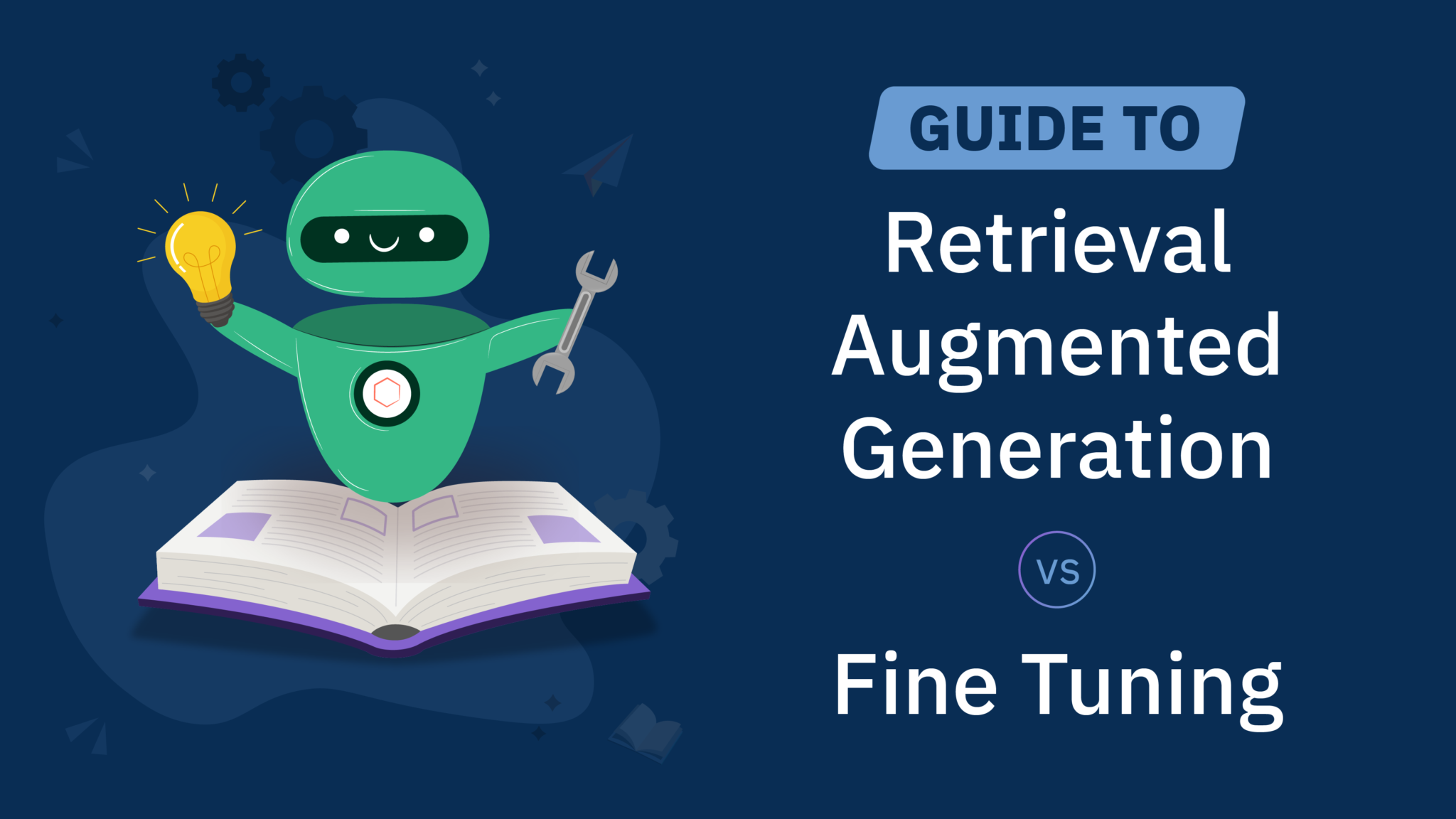
Guide to Retrieval-Augmented Generation vs. Fine Tuning
Retrieval-augmented generation (RAG) and fine-tuning are two techniques used to improve the performance of large language models (LLMs). When creating and training AI models, developers face the question of whether to use RAG, fine-tuning, or both. Here’s a closer look at retrieval-augmented generation vs. fine-tuning and how to determine the best technique for your use case.
What Is Retrieval-Augmented Generation?
Retrieval-augmented generation retrieves information from external sources to generate contextually relevant responses. While traditional generative models can only reference the data that they were trained with, RAG enables a model to find relevant information from vast amounts of data sources that are outside of the data it’s trained on. This produces more accurate and reliable responses without requiring retraining.
Use Cases for RAG
RAG is most useful when the LLM’s response needs to be grounded in data or documents.
User Support Chatbots
Companies can use RAG to give more accurate, relevant responses to customers via chatbots. With the ability to quickly scan and retrieve information from large databases, RAG allows customers to get fast answers to their questions.
RAG can also provide internal support to employees searching for information such as benefits, product details, or user support guides. Traditional self-service resources like shared folders, wikis, and Google Drive aim to empower employees, but combing through these resources can be costly and time-consuming. AI-powered chatbots, which can be created using no-code solutions like Instabase, can review documents quickly, parse information, and provide answers to their questions. By adding this extra layer of support to self-serve resources, employees can work more efficiently and smoothly.

Research
For industries or job functions that require a lot of research such as legal and medical, RAG streamlines how you search and find information. RAG connects LLMs to external databases and sources, allowing them to locate and summarize information for researchers.
Instabase’s Converse app, which uses RAG, can synthesize multiple documents and generate a summary and find answers across libraries of files in record time. It can help legal professionals review the latest legal precedents and regulations to ensure compliance. Students and researchers in any field or practice can collect the most recent information on a given topic to streamline discovery and understanding.
Educational Tools
RAG enables personalized learning, as students can ask questions and get answers or additional explanations. Additionally, RAG can offer examples, break down complex topics, and show how to arrive at the correct answer. This makes it easier for students to learn and retain information and get immediate help without relying on human availability.
Business Insights and Analysis
Businesses of every industry find themselves knee-deep in data, but combing through all that data takes a lot of time. RAG can help stakeholders efficiently analyze data and generate reports, leading to faster insights and decision-making. For example, it can summarize and analyze information from reports, live news feeds, and real-time stock market data.
What Is Fine-Tuning?
Fine-tuning “tweaks” a pre-trained language model to satisfy a specific use case. Developers may adjust the model’s neural network or parameters to make it better suited to a desired data set, task, or domain. These models are initially trained on larger data sets and then modified to focus on smaller data sets related to the specific task they serve.
Use Cases for Fine-Tuning
Fine-tuning is the best technique when LLMs need to be tailored for a specific task or to have specialized knowledge.
Named Entity Recognition
LLMs struggle with industry-specific terminology, such as medical terms or legal or technical jargon. Fine-tuning helps solve this issue by training the LLM on a more specific dataset.
Developers can fine-tune models to recognize names, entities, and other important information (companies, people, addresses, etc.) in documents. Once detected, companies can filter this data and structure their findings into databases for other purposes.
Sentiment Analysis
Models can learn to detect the emotion and tone of text through fine-tuning. Companies can apply sentiment analysis to social media, customer support chats and emails, online reviews, and forums to learn how people feel about their services, products, and brand, allowing them to adjust their messaging and offerings to improve customer satisfaction.
Personalized Content or Product Recommendations
Fine-tuning allows LLMs to provide personalized content based on the user’s preferences, interests, and behaviors, which includes articles, news, entertainment, and even product recommendations. When companies deliver highly relevant content at timely moments, they can increase user engagement and satisfaction.
Custom Chatbots
Instead of offering a generic chatbot to customers, companies can create chatbots that embody their brand with fine-tuning. Tailor your chatbot’s responses to reflect your brand’s tone and voice to create a unified customer experience. Fine-tuning can also be used to create chatbots that imitate a specific person, like a celebrity.
When to Use RAG, Fine-Tuning, or Both

It’s not always a matter of choosing retrieval-augmented generation or fine-tuning. In some cases, their synergy has the biggest impact on your generative AI application. These factors will help you determine when to use RAG, fine-tuning, or both.
Dynamic vs. Static Data
RAG works best for dynamic data because it can continuously pull information from external sources, providing up-to-date responses without retraining the model.
Fine-tuned models become outdated because they’re essentially static snapshots of the data that they’re trained on. If you have data that’s constantly changing or being updated, fine-tuning requires ongoing model training. Fine-tuned models also don’t necessarily recall historical knowledge, so outputs can be unreliable.
External Data Sources
If your application relies on external data, RAG is clearly a better option — it inherently excels at using third-party information from databases and documents.
Although fine-tuning can augment an LLM with external information, it’s not practical if you need to switch between data sources constantly. This is because it requires ongoing model training, which requires a lot of time and effort.
Model Customization
RAG and fine-tuning offer different types of customization. Fine-tuning customizes the model’s behavior, tone, terminology, and knowledge. It’s the better option when you want to customize the writing style of a model or tailor it to a specific subject matter.
RAG focuses on retrieving external information and incorporating it into the model’s response, but this doesn’t change the model’s behavior or writing style.
Hallucinations
One of the biggest problems with large language models is that they can generate incorrect outputs, which makes them unreliable and decreases user trust. Hallucinations occur due to a lack of diversity in the data set, bad data quality, or overfitting, among other reasons.
RAG drastically reduces hallucinations because responses are generated based on retrieved data. The model is less likely to come up with an answer that isn’t based on supporting information.
Fine-tuning can reduce hallucinations in the domain-specific data that’s used to train the model. However, the model can still generate inaccurate responses for queries outside of that data.
Transparency
Large language models don’t cite their sources, which leaves users wondering where the information came from. RAG provides transparency by breaking down its response generation. It can cite its sources and show the steps that it took, increasing trust with users.
Fine-tuning is more of a black box, and the model doesn’t provide insight into how it came up with its response.
Cost
In general, RAG costs less than fine-tuning because it requires less labeled data and computing power. The majority of the expenses are with building the retrieval system and maintaining ongoing infrastructure.
The cost of fine-tuning quickly adds up due to the need for more labeled data, computational resources, and high-performance hardware. Unlike RAG, fine-tuning has minimal maintenance costs, since the model doesn’t require ongoing maintenance once it’s been trained.
Implementation
RAG is easier to implement because it requires moderate technical skills. Developers need to know how to set up the retrieval mechanisms and integrate external data sources. There are also pre-built tools and frameworks that developers can leverage to quickly implement RAG.
Fine-tuning requires a high level of technical expertise since you need to retrain the model. Developers need to have an understanding of natural language processing, deep learning, data processing, and model configuration and evaluation. Fine-tuning also takes more time because you have to collect and prepare training data sets to ensure high-quality responses.
Retrieval-Augmented Generation vs. Fine-Tuning: Choosing the Right Method
RAG and fine-tuning each offer unique benefits, but it’s not always a choice of either-or. In some cases, using both might be the best option. What matters most is choosing the right technique for your application.
Instabase gives companies an easy way to leverage RAG without any engineering or technical skills through AI Hub, its suite of out-of-the-box AI applications. Using any of Instabase’s pre-built apps, users can summarize, process, and analyze data and documents. They can also quickly create and share AI chatbots within their organization to streamline information access. Get started instantly with AI Hub for free to see how RAG and large language models can help your organization do more with its unstructured data.

%20(2).png)
.png)
.png)
.png)